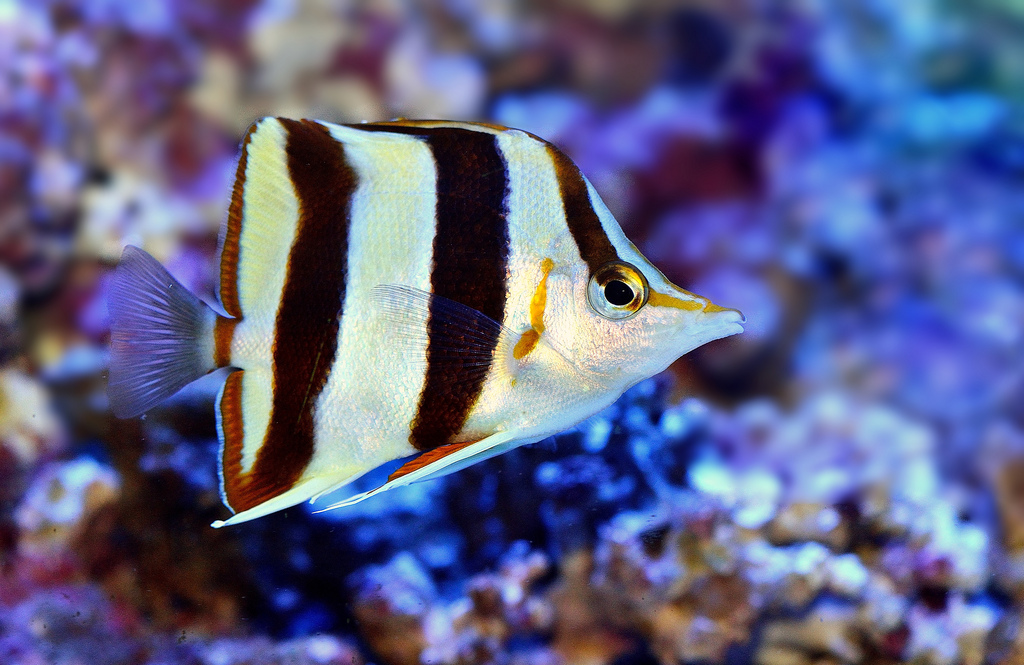Once regarded as the former capital of Japan, Kyoto relinquished its title to the anagrammatic Tokyo in 1868. Today, Kyoto is known for its serene and tranquil landscapes peppered extensively with shinto shrines, temples and historical culture. This geographical icon of the Kansai region embodies the Zen culture to full effect, and while shrines and pagodas make for good photos, so does Prognathodes “basebei”; the zenith of modern day butterflyfish.

Prognathodes is a small but handsome genus of butterflyfish with around a dozen species. They are notably fond of deepwater drop offs and ledges often exceeding 300ft in depth, and are characterised by having deep bodies, a pointed snout and very exaggerated dorsal spines. The genus closely recalls Roa, but are more often than not monochromatic and decorated with oblique stripes.
The genus is strongly represented in the Atlantic, with one species (Prognathodes guezei) reliably documented in the Indian Ocean, and another in the Pacific archipelago of Hawaii (Prognathodes sp. “basabei”). The carlhubbsi and falcifer sisters occupy the Southeastern and Eastern Pacific Ocean of the Americas, and the exceedingly rare but wide-ranging P. guyotensis has only been recorded twice from both the Indian and Western Pacific Oceans.

This beautiful species is the sole representative of its genus in Hawaii. Prognathodes n.sp is silvery cream with two prominent vertical bands, complete with a shorter, oblique one running through the eye. The dorsal and anal fin termens as well as the inner portion of its pelvic fins are ferruginous orange, lending the common name of “Orange-margined butterflyfish”.
Although this species has yet to receive an official description, it is known widely by the name Prognathodes “basabei”. The epithet “basabei” is named in honour of Pete Basabe, who assisted Richard Pyle in collecting the first specimen years ago in Kona, Hawaii. While the intention of naming this species holds true, it cannot be used officially without the quotation marks until its proper scientific description.

This species occurs in extreme depths in excess of 400ft on the main Hawaiian archipelagos. It, like most other deepwater Hawaiian endemics, can be found in significantly shallower depths in the cooler regions of the North-western Island chain. For a genus predominantly patterned in oblique bands and patches, Prognathodes “basabei” is unique in being one of only two species to possess very neat vertical bands.




The other species that adopts this striped motif is P. guezei. But, even in this species, the banding is somewhat oblique in the regular Prognathodes fashion and not nearly as straight as with “basabei”. The two species, although similar in appearance, are separated by two oceans. P. guezei is found predominantly in the Southern and Eastern African coast, and is likely the sister counterpart of P. “basabei”.
Although quite a significant number of this species have been collected by Rufus Kimura in Hawaii over the recent years, this single specimen of Prognathodes “basabei” is one of the few, if only, living specimens alive anywhere today. It’s almost a decade old and resides in a reef tank belonging to Mr. “N” in Kyoto. For fish nerds familiar with Japanese prints and magazines, you might find this set up familiar. Mr. “N” owns a wild caught Genicanthus personatus and Centropyge debelius as well. They, however, are sadly no longer alive.

The long lived P. “basabei” shares its tank with a few other rarities, including its distantly related cousin Prognathodes guyanensis, Rainfordia opercularis and a pair of incredible Pseudanthias hawaiiensis. As with most Japanese owned reef fish, these are all incredibly old and well cared for.
Mr. N’s rare butterflyfish is only just the tip of the preverbal iceberg. Like the Peppermint and Debelius Angelfish from our previous articles, there’s still way more to come, and way more to see.






